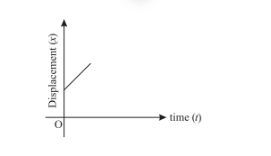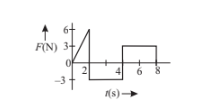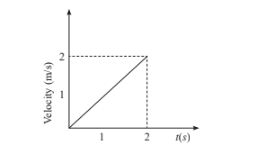
Newton's Laws of Motion MCQs: Newton's Laws of Motion is a fundamental chapter in Class 11 Physics, important for understanding key concepts in mechanics. A strong grasp of this chapter is vital for success in both CBSE board exams and competitive exams like NEET. This article offers a thorough collection of MCQs on Newton's Laws of Motion, designed following the latest NEET Physics syllabus and the chapter-wise weightage. Practicing these MCQs will improve your problem-solving abilities, strengthen your understanding of core physics principles, and increase your confidence to perform well in exams.
If you are a Class 11 NEET aspirant seeking MCQs for Physics, Chemistry, and Biology, Physics Wallah offers a complete range of resources. Physics Wallah course for Class 11 NEET includes thorough study materials, integrated tests, practice exams, and a performance analysis tool.Newton's Laws of Motion MCQ
Chapter 5 of Class 11 Physics covers Newton's Laws of Motion, which are fundamental to understanding physics. This chapter's multiple-choice questions (MCQs) cover key concepts such as inertia, force, and acceleration. These questions are designed to align with the latest CBSE and NEET Physics syllabus, ensuring that students are well-prepared for their exams. For NEET aspirants, a strong understanding of Newton's Laws of Motion is essential, as questions from this chapter frequently appear in the exam. Regular practice of these MCQs helps students grasp the core principles and apply them effectively to solve challenging problems.Also check:
Newton Law of Motion NEET Questions
Newton's Laws of Motion are basic principles in classical mechanics that explain how an object's movement is influenced by the forces acting on it. These laws are essential for understanding how objects behave in the physical world. Practicing Newton's Law of Motion NEET Questions helps students get used to the types of questions they might encounter on the exam. These questions can range from simple force calculations to more challenging problems involving multiple forces and motion in different directions. Regular practice strengthens foundational knowledge and enhances problem-solving abilities.Newton's Laws of Motion Class 11 MCQ
For Class 11 students, a thorough understanding of Newton's Laws of Motion is essential for success in both board exams and NEET. This chapter includes several key topics:- Newton's First Law of Motion (Law of Inertia): This principle explains the concept of inertia and its relation to an object's state of motion.
- Newton's Second Law of Motion (F = ma): This law explores the relationship between force, mass, and acceleration and its application in various situations.
- Newton's Third Law of Motion (Action-Reaction): This principle examines how forces always occur in pairs and the effects of action-reaction forces.
Q 1. When a force of constant magnitude and a fixed direction acts on a moving object, then its path is
- circular
- parabolic
- straight line
- Either (2) or (3)
Q 2. Which of these can a force acting on an object not change?
- State of rest
- Mass
- Direction of motion
- Shape
Q 3. Assertion (A): Electromagnetic force is much stronger than the gravitational force.
Reason (R): Electromagnetic force dominates all phenomena at atomic and molecular scales.
- Both Assertion (A) and Reason (R) are true and Reason (R) is the correct explanation of Assertion (A).
- Both Assertion (A) and Reason (R) are true but Reason (R) is not the correct explanation of Assertion (A).
- Assertion (A) is true and Reason (R) is false.
- Assertion (A) is false and Reason (R) is true.
- Strong nuclear force > electromagnetic force > weak nuclear force > gravitational force
- Gravitational force > electromagnetic force > strong nuclear force > weak nuclear force
- Strong nuclear force > weak nuclear force > electromagnetic force > gravitational force
- Electromagnetic force > weak nuclear force > gravitational force > strong nuclear force
- photons
- gravitons
- gluons
- Mesons
- It must be at rest.
- No force is acting on it.
- Its net acceleration must be zero.
- All of these
Q 7. Assertion (A): If the net external force on the body is zero, then its acceleration is zero.
Reason (R): Acceleration does not depend on force.
- Both Assertion (A) and Reason (R) are true and Reason (R) is the correct explanation of Assertion (A).
- Both Assertion (A) and Reason (R) are true but Reason (R) is not the correct explanation of Assertion (A).
- Assertion (A) is true and Reason (R) is false.
- Assertion (A) is false and Reason (R) is true.
Statement 1: Unbalanced forces can change the direction of motion of a body.
Statement 2: A balanced force is required to accelerate the body.
Statement 3: An object moves with a uniform velocity when balanced forces are acting on it or if there is no net force acting on it.
Statement 4: Balanced force cannot bring an object at rest to motion.
- Only statement 1
- Statements 1, 3 and 4
- Statements 1, 2 and 3
- Only statement 2
Q 9. When the car takes a turn on the road, we slip to one side of the seat. This is because of;
- frictional force.
- gravitational force.
- repulsion force.
- the inertia of our body.
Q 10. A rider on horseback falls when the horse starts running all of a sudden because;
- The rider is taken back.
- The rider is suddenly afraid of falling.
- the inertia of rest keeps the upper part of the body at rest whereas the lower part of the body moves forward with the horse.
- None of these
Q 11. Newton’s first law is applicable;
- in all reference frames.
- only in inertial reference frames.
- only in non-inertial reference frames.
- None of these.
Q 12. Statement I: Mass is the measure of the inertia of a body.
Statement II: The Greater the mass, the greater the force required to change its state of rest or state of uniform motion.
- Both Statement I and Statement II are correct.
- Both Statement I and Statement II are incorrect.
- Statement I is correct and Statement II is incorrect.
- Statement I is incorrect and Statement II is correct.
Q 13. A ball is traveling with uniform translatory motion. This means that;
- it is at rest.
- the path can be a straight line or circular and the ball travels with uniform speed.
- all parts of the ball have the same velocity (magnitude and direction) and the velocity is constant.
- the center of the ball moves with constant velocity and the ball spins about its center uniformly.
Q 14. A person sitting in an open car moving at constant velocity throws a ball vertically up in the air. Its effect on air resistance is neglected. The ball falls;
- outside the car.
- in the car ahead of the person.
- in the car to the side of the person.
- exactly in the hand that threw it up.
Q 15. Statement-I: A particle is found to be at rest when seen from a frame S1 and moving with a constant velocity when seen from another frame S2. We can say both the frames are inertial.
Statement II: All frames moving uniformly with respect to an inertial frame are themselves inertial.
- Both Statement I and Statement II are correct.
- Both Statement I and Statement II are incorrect.
- Statement I is correct and Statement II is incorrect.
- Statement I is incorrect and Statement II is correct.
Q 16. Suppose a body that is acted on by exactly two forces is accelerated. For this situation mark the incorrect statement.
- The body cannot move at a constant speed.
- The velocity can never be zero.
- The sum of two forces cannot be zero
- The two forces must act in the same line.
Q 17. Dirt may be cleaned from a rug by violently shaking it for a period of time. This process is based on:
- Newton’s second law of motion
- Newton’s third law of motion
- Newton’s first law of motion
- Both (1) and (2)
Q 18. In which of the following processes no force is needed?
- For uniform acceleration
- For uniformly decelerated motion
- For linear motion
- To keep the momentum constant
Q 19. A ball of mass 100 grams is moving with a velocity of 15 m/s. Calculate the momentum associated with the ball
- 1.5 Kg m/s
- 3 Kg m/s
- 0.5 Kg m/s
- 1 kg m/s
Q 20. A player catches a ball of 200 g moving with a speed of 20 m/s. If the time taken to complete the catch is 0.5 s, the force exerted on the player’s hand is;
- 8 N
- 4 N
- 2 N
- 0
Q 21. Newton’s II law of motion connects;
- Momentum and acceleration.
- Change of momentum and velocity.
- Rate of change of momentum and external force.
- Rate of change of force and momentum.
Q 22. A body of mass m collides against a wall with a velocity v and rebounds with the same speed. Its change of momentum is;
- 2mv
- mv
- –mv
- Zero
Q 23. Bullets of 0.03 kg mass each hit a plate at the rate of 200 bullets per second with a velocity of 30 m/s. The average force acting on the plate in Newton is;
- 120
- 180
- 300
- 480
Q 24. The displacement (x) - time (t) curve of a particle is shown in the figure. The external force acting on the particle is:

- acting at the beginning part of the motion
- zero
- not zero
- None of these
Q 25. Assertion (A): It is the unbalanced force acting on an object which brings it into motion from rest.
Reason (R): Force is nothing but the power present inside the body.
- Both Assertion (A) and Reason (R) are true and Reason (R) is the correct explanation of Assertion (A).
- Both Assertion (A) and Reason (R) are true but Reason (R) is not the correct explanation of Assertion (A).
- Assertion (A) is true and Reason (R) is false.
- Assertion (A) is false and Reason (R) is true.
Q 26. The force ‘F’ acting on a particle of mass ‘m’ is indicated by the force-time graph shown below. The change in momentum of the particle over the time interval from zero to 8 s is:

- 24 Ns
- 20 Ns
- 12 Ns
- 6 Ns
Q 27. A body of mass 40g is moving with a constant velocity of 2 cm/s on a horizontal frictionless table. The force on the body (in dynes) is;
- Zero
- 39200
- 160
- 80
Q 28. For a body of 50 kg mass, the velocity-time graph is shown in the figure. The force acting on the body is:

- 25 N
- 50 N
- 12.5 N
- 100 N
Q 29. Action and Reaction (For a given system)
(a) act on the same object
(b) have the same direction
(c) have different magnitudes
(d) different in nature
- (a), (b), (c)
- (b), (c), (d)
- (a), (b), (c), (d)
- None of these
Q 30. When we kick a stone, we get hurt. Due to which one of the following properties does it happen?
- Inertia
- Momentum
- Reaction forces
- Velocity
Q 31. The forward movement in swimming takes place because of _______.
- third law of motion
- fourth law of motion
- second law of motion
- first law of motion
Q 32. A man is at rest in the middle of a horizontal plane of perfectly smooth ice. He can move himself to the shore by making use of Newton’s
- first law
- second law
- third law
- All of these
Q 33. Forces of action and reaction never cancel each other because both are;
- always equal
- always opposite
- acting on the same body
- acting on different bodies
Q 34. Rock climbers pulling their vertical rope downwards to push themselves upwards is an example of which law of motion?
- Newton’s first law of motion.
- Newton’s second law of motion.
- Newton’s third law of motion.
- None of these
Newton's Laws of Motion MCQ FAQs
Q. How do Newton’s Laws of Motion MCQs assist in NEET preparation?
Q. Are these MCQs aligned with the NEET Physics syllabus?
Q. Why should I focus on Newton's Laws of Motion MCQs for NEET preparation?
Q. How can I improve my performance in Newton's Laws of Motion MCQs?
Q. Why are MCQs on Newton's Laws of Motion important?










